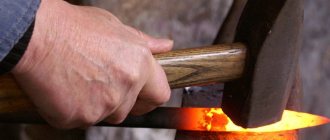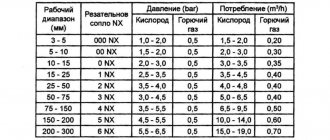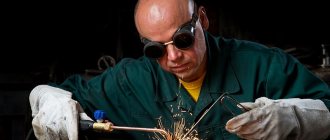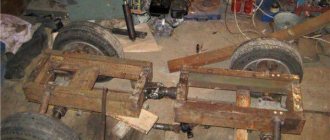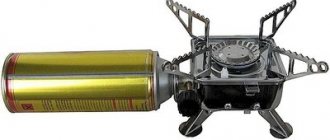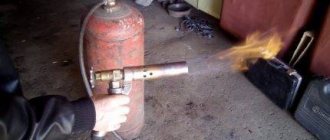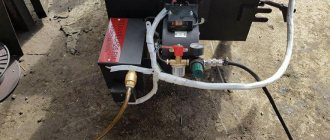Gas cutting is considered one of the most technologically advanced methods of separation cutting of rolled metal. Gas cutting of metal workpieces is carried out on special welding machines with automated controls (machine gas cutting) or using portable equipment for manual metal cutting. The main element of the kit for manual cutting is a gas cutter, often called an autogen cutter. In Fig. shows the working moment of the gas welding process of cutting a pipe, in which the welder uses a propane gas cutter.
Manufacturing
The manufacturing process occurs in several sequential stages:
- A gas supply needle is made, which acts as the tip of a gas cutter. On the needle used to inflate balls, a small incision is made using a needle file at a distance of about 2 cm from the end.
- An air (oxygen) supply needle is made. To do this, you need to take the needle from the dropper, file off the sharp tip with a sharpener, and bend it at 45 degrees at the same distance (about 2 cm). After this, the curved needle is inserted into the hole that was previously made in the large one.
- If necessary, the protruding ends of the resulting structure of two needles are leveled with a file or a sharpening stone.
- To seal the joint and fix the connection of the needles to each other, it is necessary to wrap it with copper wire, prepared in advance and cleaned of oxide. After this, the winding is coated with flux used for soldering and carefully but carefully soldered with tin.
- Dropper tubes are attached to the rear ends of the needles. In this case, the clamps are not removed from them, since they will be used to regulate the size of the flame.
- A container is made for oxygen (or ordinary air under pressure). To do this, a hole is cut in the bottom of the prepared plastic bottle for a nipple from a car camera, which is installed there using glue and a special nut. This design will allow you to pump compressed air into the bottle using an ordinary car pump. As an alternative and more convenient option, an aquarium compressor or even an electric car pump can be used.
- A hole is made in the cap of the PVC bottle to install a dropper in it, which is pre-cut to the so-called “skirt”. The connection between the cap and the dropper must also be carefully sealed using thermal adhesive.
- The resulting structure is connected using a dropper tube to the hole of a small needle. Thus, the part of the cutter through which the compressed air will have to flow is almost complete.
- A second line is made, intended for the passage of gas from the cylinder, which is used to refill lighters. It is necessary to make a hole in the plastic lid of the can, the diameter of which must coincide with the dropper tube. The tube is then inserted into the resulting hole. A special nozzle is installed at its end, which is usually supplied with the cylinder. The connection must be as tight, airtight and durable as possible. After this, the tube with the installed nozzle is fixed in the plastic cover so that in the closed position it puts pressure on the nipple of the balloon.
Your own gas cutter for metal is ready.
Industrial models (using the example of BSM)
There are special machines for industrial use to perform precise miter cutting operations. A good example: devices produced under the BSM brand. The machine manufacturer is the German company Rexinger.
True, the BSM series machines are designed exclusively for working with polypropylene pipes of fairly large diameters. Processing of products such as PP, PVC, PE, PVDF is supported.
Industrial machine for cutting pipe products made of polymers. Designed to work with large diameter products, but has equipment for processing pipes from 50 mm. The machine provides cutting in a wide range of angles
The cutting tool of the machine is a band saw, thanks to which cuts are made at angles from 0 to 67.5º. The accuracy of the process is ensured by a laser cutting recognizer.
Despite the configuration of the device for large-diameter products, you can use a special table, which can also be used to successfully cut pipes of small diameters (50 - 200 mm), which are easier to cut using a pipe cutter. A wide range of BSM devices is produced.
Tree
Wooden plinths are rare and expensive, so their processing must be approached extremely responsibly. The cutting technology looks something like this:
The cut is being made. This can be done with a regular wood hacksaw, but it is better to use a special saw or metal file to avoid cutting too wide.
Asterisk IMPORTANT: when adjusting you must be extremely careful; it is better to cover the uneven cut with a decorative overlay or wood putty than to gouge out too much wood
Skirting boards made of plastic (polyvinyl chloride, PVC) are now widespread. It is convenient because:
- Easy to cut with any tool.
- Flexible, can be used even in uneven corners.
It usually has internal cavities, which means it can be used as a cable channel for laying electrical wiring or fiber optic lines for the Internet.
PVC skirting has proven itself well
PVC skirting boards are cut in the same way as polyurethane. However, you need to take into account: the best tool, a hacksaw with fine teeth, is only suitable for thick baseboards; in thin ones it can tear out pieces. Therefore, the best option for thin products is a stationery or construction cutter or a sharp knife. Using it requires some skill, so it’s better to practice in advance on scraps or sheets of thin plastic.
Solid dry cutters
The solid type attachment, despite the name, is used for wet cutting. It does not have cuts responsible for thermal relief, and therefore requires the use of a coolant - water supply to the cutting zone. Due to the tendency to overheat, a continuous dry cutter operates continuously for no longer than 15 seconds. At idle, leave it for another half a minute to cool down.
Failure to do so will cause the silver solder to weaken, the diamond coating to wear off, and the wheel to lose its original shape.
A continuous dry cutter provides a better quality cut. The most important thing is not to forget about the water supply. Its supply can be ensured by connecting a hose or attaching a specialized device.
Exploitation
Using the device makes it possible to cut and weld metal surfaces of any complexity. Equipment running on kerosene is in demand for the coal and mining industries, because there is no risk of the device itself exploding. Due to the complexity of the design, such an autogen is not suitable for small household work.
Safety requirements
When welding metal products using an autogen, extreme caution is required and compliance with the operating rules of the device:
- To avoid an explosion, contact between the oxygen cylinder and fuels and lubricants, especially oil, is prohibited.
- during welding, periodically check the cylinders for gas leaks,
- There must be a fire extinguisher at the welding site,
- You should work away from flammable objects.
- transportation of cylinders should be carried out in vehicles equipped for the transportation of explosive materials,
- cylinders should be stored outdoors or in a ventilated cabinet.
It is not advisable to wear synthetic clothing or uncomfortable shoes so that nothing interferes with movement in an unforeseen situation.
Settings
To set up an injection cutter to perform a gas-cutting operation, you must follow the procedures regulated by the IGR operating instructions:
Check the injection in the following sequence:
- connect the hose from the oxygen cylinder to the corresponding nipple, while the nipple for connecting the gas hose remains free or is simply unscrewed;
- open the oxygen supply to the gearbox;
- open the oxygen and flammable gas valves on the IGR;
- check the injection ability by placing your finger against the gas fitting - the finger should be slightly pulled in (experienced welders do not hesitate to try the presence of retraction with the tongue instead of a finger). The presence of retraction indicates good injection.
After checking the injection, connect the flammable gas hose.
Light a flame to cut metal. The length of the torch and the color of the flame are regulated by opening the appropriate valves for oxygen, combustible gas and mixture until the flame is completely stabilized and acquires a cone shape.
How to make autogen at home
First of all, we should talk about the structure of this device. Two special boards are connected using 4 pins. Between these boards a battery is installed, consisting of electrode plates, which are made of steel and separated by special rubber rings.
A sodium hydroxide solution is pumped inside the battery. Electrolysis of water, which is provoked by constant voltage, promotes the release of hydrogen and oxygen, which allows metal cutting to be carried out.
When the gas, which passes through a special mixture of water and acetone, reaches the conditions necessary for combustion, it is supplied to a nozzle (for example, a medical needle). The combustion temperature of such gas when leaving this nozzle is at least 1800 degrees Celsius. Here is a list of all the parts of the mini-autogen, created by yourself:
- Nozzle.
- Bubble type tube.
- The basis.
- PVC tube.
- Pipe branch.
- Washer.
- The basis of the water seal.
- Terminals.
- Short pipe (3 pcs.).
- Rubber ring.
- Two boards (right and left).
- Bolt plug.
- Nuts and studs (M8, 4 pieces each).
The plates can be insulated using rubber, which must be acid- and oil- and petrol-resistant. The autogen battery should contain 9 plates, and the studs should also be insulated. The terminals must be connected to the first, seventh, eighth and ninth plates.
The voltage of the charger, which is connected through 8 plates, should be 17 V. Such indicators and the design of the device will ensure smooth heating of the metal and high-quality processing.
Video: do-it-yourself gas welding.
In order to protect against the spread of flame, an ordinary water seal is installed on gas burners (most often from empty lighter cans). To specifically prevent mixing of the water seal compositions and electrolytes, an intermediate container is provided in the burner. The pipes should be selected exclusively from copper, and their diameter should be from 4 to 6 mm.
autogenous is... What is autogenous?
- autogenous - autogenous ... Spelling dictionary-reference book
- AUTOGENOUS - AUTOGENOUS, autogenous, autogenous (Greek autogenes native) (tech.). Occurring under the influence of very high temperature by itself, without processing with tools (about cutting and welding of metals). Autogenous welding. Autogenous cutting of metals. Explanatory... ... Ushakov's Explanatory Dictionary
- AUTOGENOUS - AUTOGENOUS, oh, oh: autogenous welding, cutting is the same as gas welding, cutting. Ozhegov's explanatory dictionary. S.I. Ozhegov, N.Yu. Shvedova. 1949 1992 ... Ozhegov's Explanatory Dictionary
- autogenous - adj., number of synonyms: 1 • gas (6) ASIS Dictionary of Synonyms. V.N. Trishin. 2013 ... Dictionary of synonyms
- autogenous (sv.) - gas (sv.) - [https:///anglo russkiy slovar neftegazovoy promyishlennosti/] Topics oil and gas industry Synonyms gas (sv.) EN autogenous ... Technical Translator's Guide
- autogenous - (auto... + gr. genos genus) independently developed; a ny welding (cutting) (obsolete), or gas welding (cutting), oxygen welding (cutting) welding (cutting), in which local melting of the metal of the welded (cut) products is carried out ... ... Dictionary of foreign words of the Russian language
- Autogenous - adj. 1. ratio with noun autogen associated with it 2. Characteristic of autogen, characteristic of it. Ephraim's explanatory dictionary. T. F. Efremova. 2000 ... Modern explanatory dictionary of the Russian language by Efremova
- autogenous - autogenous, autogenous, autogenous, autogenous, autogenous, autogenous, autogenous, autogenous, autogenous, autogenous, autogenous, autogenous, autogenous, autogenous, autogenous, autogenous, autogenous, autogenous, autogenous, autogenous,... ... Forms of words
- autogenous - autogenous (technical) ... Russian spelling dictionary
- autogenous - ... Spelling dictionary of the Russian language
Implementation principle
Autogen welding always refers to a strictly thermal method. Connecting seams are obtained by melting the material used to make the parts themselves. It is also possible to use additional components from outside. During the process, the workpieces themselves are not subject to mechanical stress from the operator. To heat and melt the bases and additives being joined, the combustion reaction of certain gases is used, which occurs inside an oxygen stream.
The term “autogenous welding” began to be used to emphasize the main distinctive features of the technology, namely the presence of melting. Literally from the Greek language “autogen” is translated as “self-arising.” Subsequently, this began to be used to designate exclusively the gas welding method.
Autogen for cutting/welding metal: classification
The entire range of autogens available in specialized stores is divided according to various criteria:
- by purpose: special (for a special kind of specific work) and universal, suitable for most gas cutting and welding work. Universal torches equipped with an injector are simple and easy to use, are lightweight, and are capable of cutting workpieces with a thickness of 3...300 mm in all directions.
The type of combustible mixture forms its own classification:
- in very low-cost oxygen autogens, the formation of a burning jet occurs with oxygen;
- Kerosene cutters operate on kerosene vapor and are usually used for cutting carbon steel workpieces up to 200 mm thick. The rather complex design of such an autogen makes it practically inapplicable for small household work - kerosene autogens are usually used in the coal and mining industries (due to the high explosion hazard, propane/acetylene autogens are usually not used in these industries) ;
- considered the most reliable and safe, efficient and productive propane autogens are used for cutting ferrous and non-ferrous metals - most often for cast iron batteries, pipes, etc.;
- acetylene autogens will be the best choice when processing workpieces or elements of considerable thickness - the properties of the acetylene combustible mixture allow you to create a flame of maximum temperature: even a compact tool in its design will be convenient and effective when working with massive parts and workpieces;
- according to the design and method of mixing the oxygen and combustible components, autogens are divided into injection and non-injector;
- according to the method of metal cutting: autogenous separation, spear, surface or oxygen-flux processing (for high-chromium, high-alloy steels).
Whatever autogen is chosen by the master, it is important that it is efficient and productive, and corresponds to the nature of the work and the properties of the elements intended for cutting or welding.
Angle grinder
Working with an angle grinder is quick and convenient, but not without its drawbacks. For example, it only cuts in a straight line. An attempt to make a curved cut will result in the disc being “bitten”, breaking, and possible injury to the user. Therefore, the machine is used for straight cutting. Another disadvantage is the fire hazard of the method (abrasive disc + metal = sparking). Before work, you will have to wear goggles, protection for your face and hands.
Cutting with a circle is more efficient than with a jigsaw, which is why users often choose a noisy grinder. When buying a cutting wheel, prefer products with a bakelite bond, because they are much stronger than their ceramic counterparts.
Autogen. How to cut metal with gas?
Carrying out gas cutting or gas welding work requires not only careful adherence to safety precautions, but also specialized equipment: an autogen, also commonly called a gas torch or a gas cutter, will help perform work of varying complexity quickly, efficiently, and professionally. In the article you will learn about the operating principle and classification of this tool. Gas cutting using autogen is a very common procedure, which is based on the property of metal to heat up under the influence of high temperatures, which makes it easy to cut it in the desired direction. The main areas of application of autogens are installation and construction work - both professional (industrial) and household; To perform welding, in addition to the autogen, a filler rod is required.
How does autogen work?
Technical progress has somewhat changed the design of the autogen, which initially included a gas burner, an oxygen cylinder, an acetylene generator and connecting hoses; the control and reduction of oxygen pressure was carried out by a reducer with a pressure gauge.
Over time, for greater convenience, the acetylene generator with automatic maintenance of gas pressure was replaced by an acetylene cylinder, but the name “autogen”, probably derived from the combination of the words “automatic generator”, has taken root and is widely used by craftsmen.
The operating principle of the autogen is based on the property of metal to burn in chemically pure oxygen, and therefore there are two key points that are necessary when operating the cutter: a direct cutting jet of pure oxygen and a heating gas (usually acetylene or propane).
The design of a modern autogen is quite simple and represents the interaction of two basic functional parts:
- a tip for supplying a jet of cutting flame, having internal and external mouthpieces united by a nozzle nozzle;
- a barrel with a chamber connecting gas and oxygen and valves located on the body for connecting hoses to oxygen and gas units and adjusting the gas supply volume, speed and pressure of the oxygen jet.
The reduced pressure (the required level of oxygen discharge) is formed due to the injection barrel, where oxygen is partially supplied and from where the jet exits into the mouthpiece channel at high speed.
Another direction of oxygen movement will be the main channel of the internal mouthpiece, which forms the cutting jet.
The mixing section of the autogen is necessary to combine the gas component (acetylene or propane) and oxygen - in the future, this mixture will become a heating flame supplied between the internal and external mouthpiece of the tip. The tip is attached to the barrel using an ordinary union nut.
Structurally, the models of various cutters from different manufacturers may have some nuances, but in general the configurations and operating principle are quite traditional - changes in the design mostly bring ease of use and greater safety. Modern gas cutting or welding is already unthinkable without these tools.
Autogen for cutting/welding metal: classification
The entire range of autogens available in specialized stores is divided according to various criteria:
- by purpose: special (for a special kind of specific work) and universal, suitable for most gas cutting and welding work. Universal torches equipped with an injector are simple and easy to use, are lightweight, and are capable of cutting workpieces with a thickness of 3...300 mm in all directions.
The type of combustible mixture forms its own classification:
- in very low-cost oxygen autogens, the formation of a burning jet occurs with oxygen;
- Kerosene cutters operate on kerosene vapor and are usually used for cutting carbon steel workpieces up to 200 mm thick. The rather complex design of such an autogen makes it practically inapplicable for small household work - kerosene autogens are usually used in the coal and mining industries (due to the high explosion hazard, propane/acetylene autogens are usually not used in these industries) ;
- considered the most reliable and safe, efficient and productive propane autogens are used for cutting ferrous and non-ferrous metals - most often for cast iron batteries, pipes, etc.;
- acetylene autogens will be the best choice when processing workpieces or elements of considerable thickness - the properties of the acetylene combustible mixture allow you to create a flame of maximum temperature: even a compact tool in its design will be convenient and effective when working with massive parts and workpieces;
- according to the design and method of mixing the oxygen and combustible components, autogens are divided into injection and non-injector;
- according to the method of metal cutting: autogenous separation, spear, surface or oxygen-flux processing (for high-chromium, high-alloy steels).
Whatever autogen is chosen by the master, it is important that it is efficient and productive, and corresponds to the nature of the work and the properties of the elements intended for cutting or welding.
Mini cutter
A manual autogen is usually small in size - an even smaller version of it is called a mini-cutter. The main characteristics of such a tool include a confident flame pressure and a gas tank of sufficient volume, allowing the device to be used even in windy weather.
During operation, it should be taken into account that the mini - autogen is not designed for long-term continuous use: high temperatures can melt the tool body without the possibility of repair or replacement of damaged parts.
However, the time of use is limited by the volume of the gas tank: the autogen lighter must be refilled periodically, and for this a regular collet cylinder is useful. Unlike convenient and efficient modern manual models (including a rather expensive autogen with piezo ignition, activated by pressing just one button), mini-cutters are characterized by low cost, and therefore are available to literally everyone, not only professional, but also home craftsmen. The main areas of use of such an autogen are household work that requires cutting or welding of metal elements: repair of air conditioners, cars, bicycles, refrigerators, etc. The disadvantages of the tool include the short length of the cutting flame, which somewhat limits the work of such a device with certain types of metals.
Operation of the autogen and features of its use
The sequence of working with autogen can be represented by the following steps:
- Studying the structure and operating principles of a particular model, checking the correct location of the autogen parts, connecting the hoses for supplying flammable gas and oxygen.
- Special rubber seals are treated with glycerin or a lubricant provided for this purpose. It is important that the connections of the threaded type autogen components are sealed - this minimizes the risk of gas leakage during operation of the gas autogen.
- By supplying a dosed stream of oxygen, a vacuum of gas is formed in the channels of the instrument.
- Opening the gas valve will ignite the combustible mixture, which heats the metal to a temperature sufficient for cutting.
- Valves on the oxygen and gas supply channels regulate the size of the cutting flame, the intensity and temperature of combustion in accordance with the materials of the workpiece, its thickness, etc.
- At the moment the metal, heated to the required temperature, is absolutely ready for cutting, a stream of cutting oxygen is supplied, and the part is cut properly.
- Extinguishing the burner flame is carried out in the reverse order - first the gas channel valve is tightened, then the oxygen channel. If the tip becomes very hot (which is quite possible during long-term work), cooling is carried out with cold water.
During operation, switching on and off the device, as well as its storage, fire safety rules should be followed and strictly observed.
Autogen maintenance
Proper use and after-use maintenance will not only make the work safe, but will also significantly extend the service life of the autogen.
A technological feature of autogen is the rapid wear of the nozzle and mouthpieces - internal and external, which are directly exposed to pure oxygen and gas.
The solution to this problem will be regular cleaning of the nozzle channels with a soft copper rod of suitable length, and with experience and work skill, competent and accurate selection of the match between the thickness of the metal workpiece and the pressure of the supplied cutting mixture will not allow the use of the autogen, as they say, for wear.
Autogen prices vary over a wide cost range: it is formed depending on the design and type of tool, its characteristics, functionality, purpose (domestic or industrial work), and country. High-quality and reliable, with a solid warranty period, models of gas cutters produced in South Korea or America are among the most expensive.
Selection and use of a gas cutter for metal
[Glass cutter] refers to one of the varieties of a special hand-held unit for cutting metal, which is produced by heating it to a high temperature.
In everyday life it is called an autogen or a gas burner.
The use of such devices makes it possible to separate metal sheets into separate pieces, both large and small (the particles can be very small, for example, for jewelry work).
If you are planning to make repairs, then it will be difficult to do without this device. To make the right choice, you must know the characteristics of the cutters and how to use this or that type of device.
In this case, the devices are special and universal, which in turn are also divided into ejectorless and ejector and have different characteristics.
Separation depends on how the oxygen mixes with the flammable gas.
If we talk about the cutting method, there are also several varieties: spear, surface, separation and oxygen-flux.
One type or another is assigned depending on the type of flammable solution that is involved in the work.
Fuel for autogens is supplied in a gaseous state and is a source of their thermal energy.
Refueling can be done with propane, hydrogen, acetylene or even kerosene vapor. The propane option is one of the most popular.
Gas burners are mainly used for installation work at a factory or construction site for industrial purposes, but they are also suitable for DIY work at home (for example, they are used when repairing a car).
In this case, you just need to choose the type of burner that suits you.
Types of units
If you are planning to make a repair and are choosing a device, then the following information will definitely interest you.
There are quite a few types of cutters. They all have different devices and characteristics.
Let's study the most popular of them:
- The oxygen apparatus is an ejector unit in which the burning jet is formed by oxygen supplied under pressure. The oxygen autogen is considered one of the most budget-friendly devices and is quite suitable for DIY cutting;
- A kerosene cutter, as the name suggests, operates using kerosene vapor. As a rule, it is used when cutting carbon steel no more than 20 cm thick. It is almost never used for cutting with your own hands, since it has a complex structure and is used mainly in industrial work (the characteristics of the burner allow it to be used in the coal or mining industry, underground , while it is undesirable to use a propane or acetylene cutter there);
- A propane machine is used when cutting products that contain non-ferrous and ferrous metals of different compositions (most often, a propane autogen is used when cutting cast iron - batteries or pipes). Professionals pay attention to the safety and reliability that a propane device provides compared to the use of other units. Therefore, it is propane autogen that is most often used when doing DIY work. In addition, if you use the propane method of metal cutting, you can be sure that efficiency and productivity are guaranteed;
- An acetylene gas torch is used to process parts and sheets that are thick. All such burners have separate valves, with the help of which you can set a higher speed and power of gas supply during operation. There are even portable cutters that require an acetylene mixture to cut metal. Since acetylene allows the flame to reach the highest temperature, despite the compact size of the device, it can cut even very thick metal. This portable cutter is extremely convenient for DIY use and is therefore in great demand.
But still, universal ejector devices are the most popular. Universal autogens can cut metal in any direction and at any angle.
IMPORTANT TO KNOW: Choosing an angle grinder for your home and garden
At the same time, they are extremely easy to use and are lightweight. One of the latest developments by manufacturers is a gas cutter with piezo ignition.
:
It is extremely convenient for do-it-yourself use, since such a device is turned on with one press of a button.
But such an autogen is quite expensive, so if you need a device for a short period of time and for a small volume of metal cutting, then purchasing such a torch will be inappropriate and wasteful. It is much better to buy a mini cutter.
Burner structure
The structure of the burner itself is very simple. It includes a tip for supplying a jet of fire and a barrel through which gas is supplied.
To attach the barrel to the cutter body, use a regular union nut.
The barrel itself consists of an ejector, inlets with nipples (through which gas hoses are connected to the autogen), nozzles, a mixing chamber and two valves.
Despite the different characteristics of the device models and differences in their performance, weight and dimensions, they all have the same operating principle.
First, gases are supplied through hoses (main fuel and oxygen), which are connected to a small chamber.
The gases are mixed in the chamber, after which they come out under pressure through the release device (mouthpiece).
In this case, you can control the flow rate of the mixture, and regulate the combustion intensity and temperature. Regulation is provided by two valves (one for each gas).
A stream of fire coming out of the burner and hitting the metal begins to quickly heat it up. As a result, the metal becomes soft, begins to melt and can be easily cut.
As you can see, the principle of operation is very simple.
Therefore, to carry out metal cutting work, it is not necessary to call professionals; you can do everything yourself, while observing fire safety measures.
The photo shows the structure of the burner with symbols so that you can visually study everything before starting work.
Using the cutter
Before you start using the machine for metal, the device must be prepared.
First, we check whether the gas hoses are connected correctly (the oxygen supply hose is connected to a fitting with a right-hand thread, and the hose for supplying flammable gas to a fitting with a left-hand thread).
Secondly, we tighten all connections and check how tight they are to avoid leakage of the mixture during work.
It is advisable to lubricate the rubber valve seals using a special lubricant or glycerin. Only after this can you light the cutter and start cutting metal.
The sequence is extremely simple:
- first open the valve with oxygen, then the valve with gas;
- ignite the flammable mixture coming out of the release device;
- we adjust the flame jet to the required size and intensity using valves;
- heat the metal until the heating area becomes straw-colored;
- open the valve with cutting oxygen and cut the material;
- Having completed the cutting, first close the gas valve, then the oxygen valve;
- If the tip gets very hot, you can immerse it in cold water.
When working, you should be extremely careful and avoid mistakes.
If you do the cutting yourself, be sure to wear special gloves and a protective mask.
IMPORTANT TO KNOW: Types of metal milling machines
Clothes should be made from natural materials; it is advisable not to wear synthetics or flammable materials when working with fire.
Shoes should be comfortable so that you can move easily and quickly in them if an unexpected situation arises.
Metal cutting should only be done on a specially prepared, grease-free surface.
If oxygen comes into contact with even a small amount of oil, the rate of explosion is extremely high.
Therefore, under no circumstances should you touch the cylinder with oily hands! Smoking while working indoors is also strictly prohibited!
Do not panic if during work your gas supply hose falls off or breaks (since the gas comes under pressure, this sometimes happens).
:
Those who encounter this for the first time are in most cases frightened by the loud sound that occurs at this moment.
In this case, you should turn off the propane first and then the oxygen as quickly as possible.
After use, the gas cutter should be stored in a specially designated place to prevent the ingress of oil and grease.
The gearboxes are stored separately, and the cutter and welding torch can be placed together.
Price and repair
How much does a device like this cost? Everyone who is planning to make repairs with their own hands is eager to find out the answer to this question.
The price of a gas autogen can vary greatly. It is influenced by the country of manufacture, company, type, size, characteristics and purpose of the device.
The highest price is considered to be for gas burners made in South Korea or America, as they are of high quality and have a long warranty period.
Chinese burners have the lowest price, but the quality leaves much to be desired.
If you wish, you can easily find a high-quality device that will have an acceptable price and good characteristics, you just need to decide what is your priority - size, performance or purpose of the device.
If after purchase you find any problems with the device, you can use the warranty card.
:
The seller is obliged to carry out free repairs at the service center or exchange the device for another similar model.
After the end of the warranty period, if the autogen breaks down, you will make repairs at your own expense.
Therefore, it is advisable to buy burners from trusted manufacturers, so that in the future repairing the device will not cost more than the purchase itself. The price of the device is not the criterion that should be used when choosing a cutter.
Autogen maintenance
Proper use and after-use maintenance will not only make the work safe, but will also significantly extend the service life of the autogen. A technological feature of autogen is the rapid wear of the nozzle and mouthpieces - internal and external, which are directly exposed to pure oxygen and gas. The solution to this problem will be regular cleaning of the nozzle channels with a soft copper rod of suitable length, and with experience and work skill, competent and accurate selection of the match between the thickness of the metal workpiece and the pressure of the supplied cutting mixture will not allow the use of the autogen, as they say, for wear.
Autogen prices vary over a wide cost range: it is formed depending on the design and type of tool, its characteristics, functionality, purpose (domestic or industrial work), and country. High-quality and reliable, with a solid warranty period, models of gas cutters produced in South Korea or America are among the most expensive.
Necessary equipment for gas welding
Gas welding equipment is used to join or cut metal elements under high temperature. It involves the use of different types of devices and accessories, depending on the type of work performed. Several components are used to process metal.
Water or liquid seal
Protects parts of devices from the backlash of the welding flame. This can happen when the gas flow rate is less than the combustion speed, or when the burner mouthpiece passages are clogged. All generators are equipped with this safety device.
Gas cylinders
Special cylindrical tanks with valves for storing and transporting chemicals. You can tell what type they contain by color.
Gearbox
Reduces gas pressure or keeps it at a certain level. The device is available in direct and reverse action. This is an important element of gas equipment that determines the performance of the entire system. There are different types of devices, including an oxygen reducer. It is adapted to aggressive environments and has blue markings.


